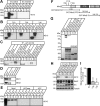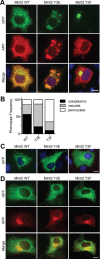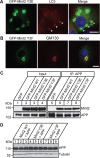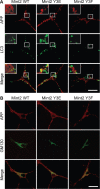Intracellular amyloid precursor protein sorting and amyloid-β secretion are regulated by Src-mediated phosphorylation of Mint2
- PMID: 22787047
- PMCID: PMC3404619
- DOI: 10.1523/JNEUROSCI.0602-12.2012
Intracellular amyloid precursor protein sorting and amyloid-β secretion are regulated by Src-mediated phosphorylation of Mint2
Abstract
Mint adaptor proteins bind to the membrane-bound amyloid precursor protein (APP) and affect the production of pathogenic amyloid-β (Aβ) peptides related to Alzheimer's disease (AD). Previous studies have shown that loss of each of the three Mint proteins delays the age-dependent production of amyloid plaques in transgenic mouse models of AD. However, the cellular and molecular mechanisms underlying Mints effect on amyloid production are unclear. Because Aβ generation involves the internalization of membrane-bound APP via endosomes and Mints bind directly to the endocytic motif of APP, we proposed that Mints are involved in APP intracellular trafficking, which in turn, affects Aβ generation. Here, we show that APP endocytosis was attenuated in Mint knock-out neurons, revealing a role for Mints in APP trafficking. We also show that the endocytic APP sorting processes are regulated by Src-mediated phosphorylation of Mint2 and that internalized APP is differentially sorted between autophagic and recycling trafficking pathways. A Mint2 phosphomimetic mutant favored endocytosis of APP along the autophagic sorting pathway leading to increased intracellular Aβ accumulation. Conversely, the Mint2 phospho-resistant mutant increased APP localization to the recycling pathway and back to the cell surface thereby enhancing Aβ42 secretion. These results demonstrate that Src-mediated phosphorylation of Mint2 regulates the APP endocytic sorting pathway, providing a mechanism for regulating Aβ secretion.
Figures








References
-
- Blom N, Gammeltoft S, Brunak S. Sequence and structure-based prediction of eukaryotic protein phosphorylation sites. J Mol Biol. 1999;294:1351–1362. - PubMed
-
- Bolte S, Cordelières FP. A guided tour into subcellular colocalization analysis in light microscopy. J Microscopy. 2006;224:213–232. - PubMed
-
- Bonifacino JS. The GGA proteins: adaptors on the move. Nat Rev Mol Cell Biol. 2004;5:23–32. - PubMed
Publication types
MeSH terms
Substances
Grants and funding
LinkOut - more resources
Full Text Sources
Miscellaneous
